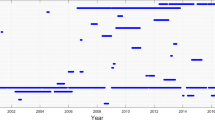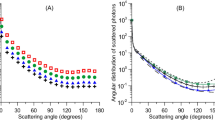Abstract
THE relationship between pollutant emissions and the optical haze characteristic of photochemical smog has proved difficult to unravel1,2. It is clear that material produced by reaction in the atmosphere is responsible for much of the deterioration in the optical environment, since the ambient aerosol scatters much more light at a given mass concentration than do the primary aerosols emitted by known sources3,4. Unfortunately, measurement of the scattering contributed by an individual product species is complicated by the fact that most of this secondary material is deposited on existing particles and cannot be isolated for direct observation of its in situ optical properties. In this note I present statistical evidence from measurements in Los Angeles that secondary sulphate compounds scatter visible light more efficiently than do other chemical fractions of the ambient aerosol. My results indicate that sulphur emissions can strongly influence atmospheric visibility even in photochemical smog of the Los Angeles variety, where secondary organics and nitrates contribute most of the pollutant aerosol mass.
This is a preview of subscription content, access via your institution
Access options
Subscribe to this journal
Receive 51 print issues and online access
$199.00 per year
only $3.90 per issue
Buy this article
- Purchase on Springer Link
- Instant access to full article PDF
Prices may be subject to local taxes which are calculated during checkout
Similar content being viewed by others
References
Thomas, M. D., Int. J. Air Water Pollution, 6, 443 (1962).
Keith, R. W., Air Quality Report No. 65 (Los Angeles Air Pollution Control District, 1970).
Charlson, R. J., et al., J. Air Pollution Control Ass., 19, 937 (1969).
Elder, J. C., Ettinger, H. J., and Nelson, R. Y., Atmos. Envir., 8, 1035 (1974).
Husar, R. B., White, W. H., and Blumenthal, D. L., Envir. Sci. Tech., 10, 490 (1976).
Horvath, H., and Noll, K. E., Atmos. Envir., 3, 543 (1969).
Hidy, G. M., et al., Characterization of Aerosols in California, Final Report (California Air Resources Board, 1974).
Garland, J. A., Atmos. Envir., 3, 347 (1969).
Covert, D. S., Charlson, R. J., and Ahlquist, N. C., J. appl. Met., 11, 968 (1972).
White, W. H., and Roberts, P. T., Paper No. 75-28.6 (Air Pollution Control Association Annual Meeting, 1975).
Waggoner, A. P., et al., Nature, 261, 120 (1976).
Friedlander, S. K., J. Met., 17, 373 (1960).
Author information
Authors and Affiliations
Rights and permissions
About this article
Cite this article
WHITE, W. Reduction of visibility by sulphates in photochemical smog. Nature 264, 735–736 (1976). https://doi.org/10.1038/264735a0
Received:
Accepted:
Issue Date:
DOI: https://doi.org/10.1038/264735a0
Comments
By submitting a comment you agree to abide by our Terms and Community Guidelines. If you find something abusive or that does not comply with our terms or guidelines please flag it as inappropriate.



